Kenyatta University, EAE 405: Development Planning Report Analysis
VerifiedAdded on 2022/03/24
|75
|17571
|12
Report
AI Summary
This report, prepared for Kenyatta University's EAE 405 Development Planning course, provides a comprehensive overview of the subject. It begins with an introduction to development planning, exploring its nature, rationale, and different categories, including anti-cyclical and development planning. The report then examines the resource requirements for planning, covering both human and non-human resources, and delves into various planning techniques and strategies, such as input-output models and project analysis. It further explores different types of economic planning procedures and mechanisms, followed by case studies of development planning experiences in countries like the former USSR, Israel, and Kenya. Finally, the report discusses critical issues in development planning, including the causes of plan failures in developing countries and the impact of socio-economic integration. The report is a valuable resource for students studying development economics and planning.
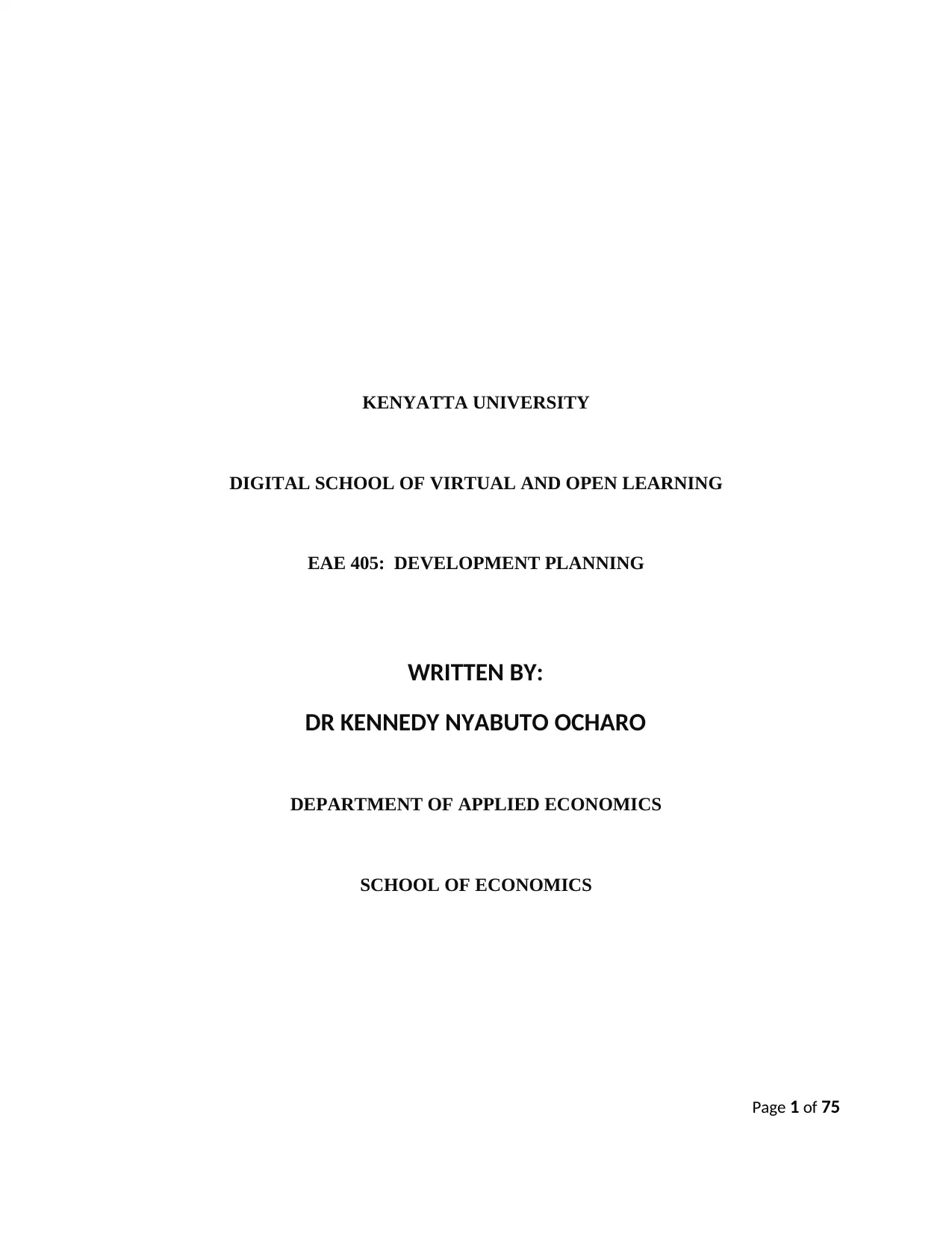
KENYATTA UNIVERSITY
DIGITAL SCHOOL OF VIRTUAL AND OPEN LEARNING
EAE 405: DEVELOPMENT PLANNING
DEPARTMENT OF APPLIED ECONOMICS
SCHOOL OF ECONOMICS
Page 1 of 75
WRITTEN BY:
DR KENNEDY NYABUTO OCHARO
DIGITAL SCHOOL OF VIRTUAL AND OPEN LEARNING
EAE 405: DEVELOPMENT PLANNING
DEPARTMENT OF APPLIED ECONOMICS
SCHOOL OF ECONOMICS
Page 1 of 75
WRITTEN BY:
DR KENNEDY NYABUTO OCHARO
Paraphrase This Document
Need a fresh take? Get an instant paraphrase of this document with our AI Paraphraser
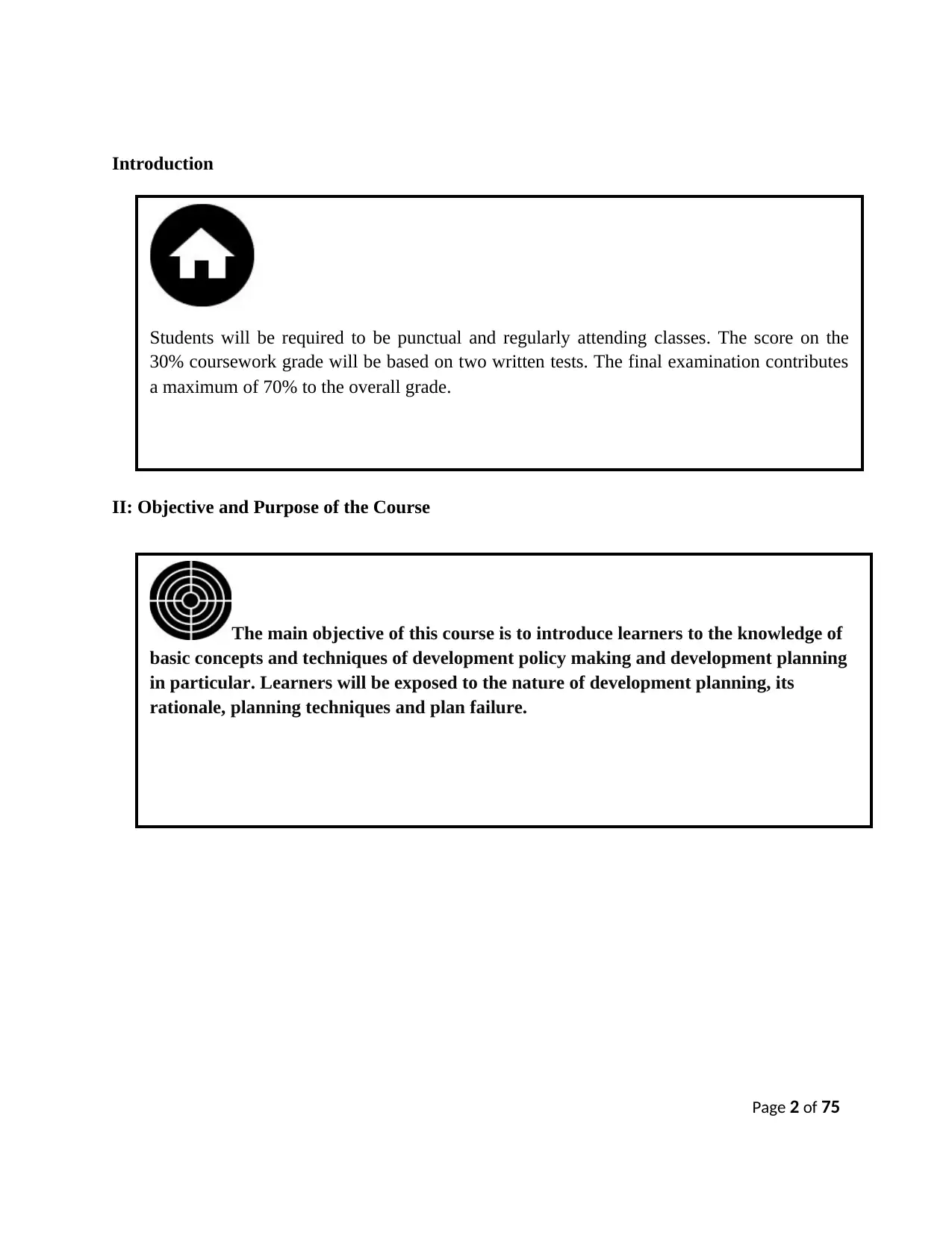
Introduction
II: Objective and Purpose of the Course
Page 2 of 75
Students will be required to be punctual and regularly attending classes. The score on the
30% coursework grade will be based on two written tests. The final examination contributes
a maximum of 70% to the overall grade.
The main objective of this course is to introduce learners to the knowledge of
basic concepts and techniques of development policy making and development planning
in particular. Learners will be exposed to the nature of development planning, its
rationale, planning techniques and plan failure.
II: Objective and Purpose of the Course
Page 2 of 75
Students will be required to be punctual and regularly attending classes. The score on the
30% coursework grade will be based on two written tests. The final examination contributes
a maximum of 70% to the overall grade.
The main objective of this course is to introduce learners to the knowledge of
basic concepts and techniques of development policy making and development planning
in particular. Learners will be exposed to the nature of development planning, its
rationale, planning techniques and plan failure.
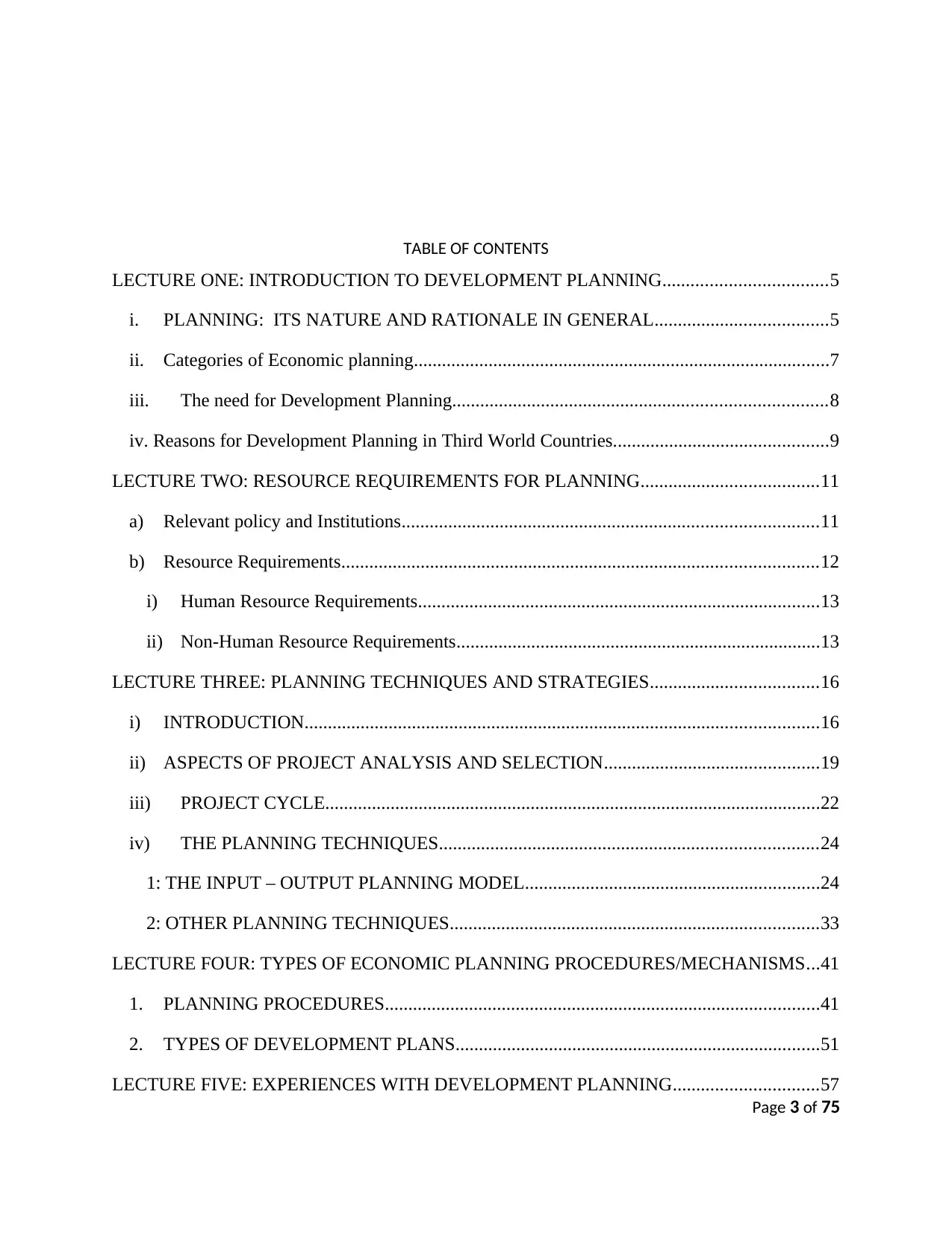
TABLE OF CONTENTS
LECTURE ONE: INTRODUCTION TO DEVELOPMENT PLANNING...................................5
i. PLANNING: ITS NATURE AND RATIONALE IN GENERAL.....................................5
ii. Categories of Economic planning.........................................................................................7
iii. The need for Development Planning................................................................................8
iv. Reasons for Development Planning in Third World Countries..............................................9
LECTURE TWO: RESOURCE REQUIREMENTS FOR PLANNING......................................11
a) Relevant policy and Institutions.........................................................................................11
b) Resource Requirements......................................................................................................12
i) Human Resource Requirements......................................................................................13
ii) Non-Human Resource Requirements..............................................................................13
LECTURE THREE: PLANNING TECHNIQUES AND STRATEGIES....................................16
i) INTRODUCTION..............................................................................................................16
ii) ASPECTS OF PROJECT ANALYSIS AND SELECTION..............................................19
iii) PROJECT CYCLE..........................................................................................................22
iv) THE PLANNING TECHNIQUES.................................................................................24
1: THE INPUT – OUTPUT PLANNING MODEL...............................................................24
2: OTHER PLANNING TECHNIQUES...............................................................................33
LECTURE FOUR: TYPES OF ECONOMIC PLANNING PROCEDURES/MECHANISMS...41
1. PLANNING PROCEDURES.............................................................................................41
2. TYPES OF DEVELOPMENT PLANS..............................................................................51
LECTURE FIVE: EXPERIENCES WITH DEVELOPMENT PLANNING...............................57
Page 3 of 75
LECTURE ONE: INTRODUCTION TO DEVELOPMENT PLANNING...................................5
i. PLANNING: ITS NATURE AND RATIONALE IN GENERAL.....................................5
ii. Categories of Economic planning.........................................................................................7
iii. The need for Development Planning................................................................................8
iv. Reasons for Development Planning in Third World Countries..............................................9
LECTURE TWO: RESOURCE REQUIREMENTS FOR PLANNING......................................11
a) Relevant policy and Institutions.........................................................................................11
b) Resource Requirements......................................................................................................12
i) Human Resource Requirements......................................................................................13
ii) Non-Human Resource Requirements..............................................................................13
LECTURE THREE: PLANNING TECHNIQUES AND STRATEGIES....................................16
i) INTRODUCTION..............................................................................................................16
ii) ASPECTS OF PROJECT ANALYSIS AND SELECTION..............................................19
iii) PROJECT CYCLE..........................................................................................................22
iv) THE PLANNING TECHNIQUES.................................................................................24
1: THE INPUT – OUTPUT PLANNING MODEL...............................................................24
2: OTHER PLANNING TECHNIQUES...............................................................................33
LECTURE FOUR: TYPES OF ECONOMIC PLANNING PROCEDURES/MECHANISMS...41
1. PLANNING PROCEDURES.............................................................................................41
2. TYPES OF DEVELOPMENT PLANS..............................................................................51
LECTURE FIVE: EXPERIENCES WITH DEVELOPMENT PLANNING...............................57
Page 3 of 75
⊘ This is a preview!⊘
Do you want full access?
Subscribe today to unlock all pages.

Trusted by 1+ million students worldwide
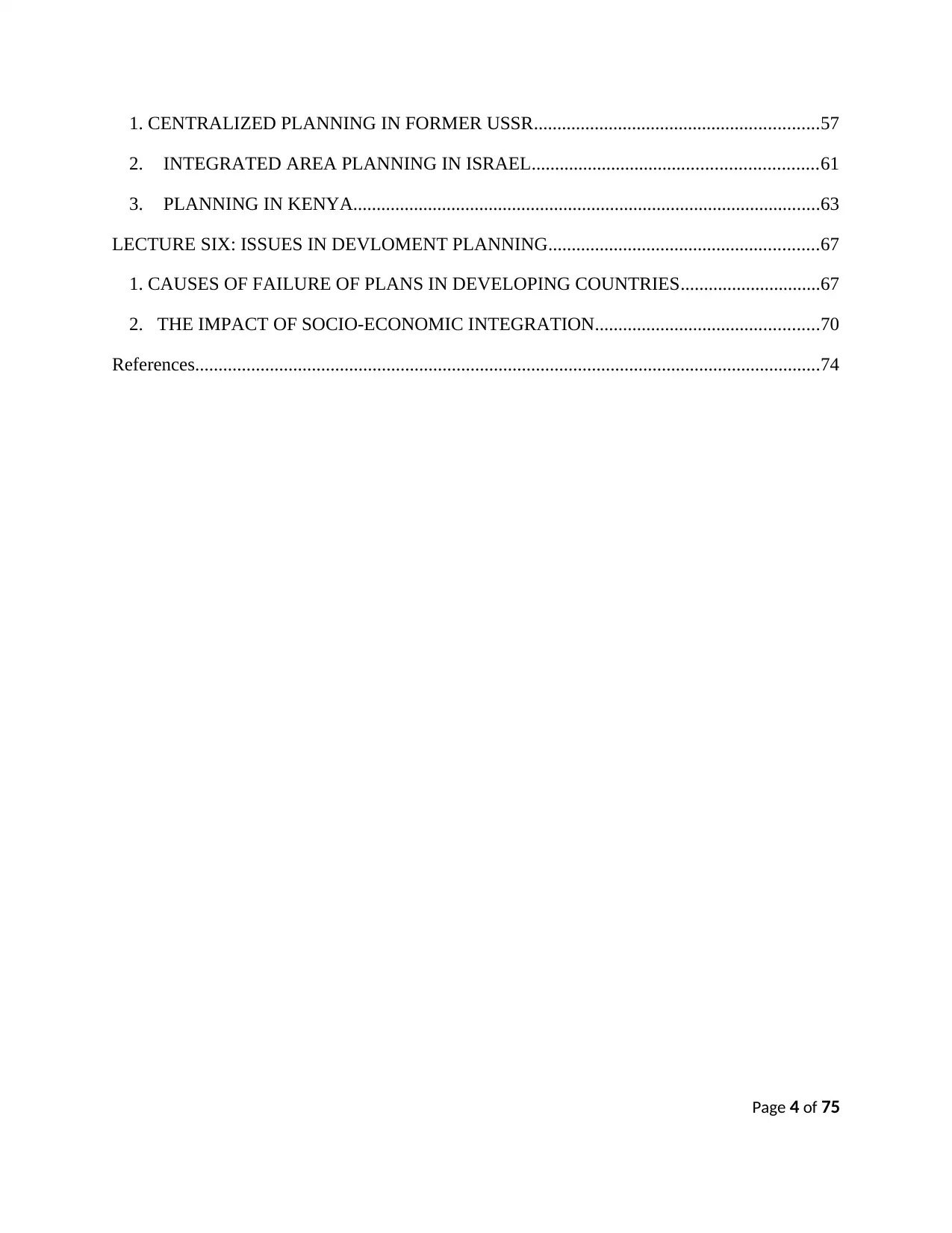
1. CENTRALIZED PLANNING IN FORMER USSR.............................................................57
2. INTEGRATED AREA PLANNING IN ISRAEL.............................................................61
3. PLANNING IN KENYA....................................................................................................63
LECTURE SIX: ISSUES IN DEVLOMENT PLANNING..........................................................67
1. CAUSES OF FAILURE OF PLANS IN DEVELOPING COUNTRIES..............................67
2. THE IMPACT OF SOCIO-ECONOMIC INTEGRATION................................................70
References......................................................................................................................................74
Page 4 of 75
2. INTEGRATED AREA PLANNING IN ISRAEL.............................................................61
3. PLANNING IN KENYA....................................................................................................63
LECTURE SIX: ISSUES IN DEVLOMENT PLANNING..........................................................67
1. CAUSES OF FAILURE OF PLANS IN DEVELOPING COUNTRIES..............................67
2. THE IMPACT OF SOCIO-ECONOMIC INTEGRATION................................................70
References......................................................................................................................................74
Page 4 of 75
Paraphrase This Document
Need a fresh take? Get an instant paraphrase of this document with our AI Paraphraser
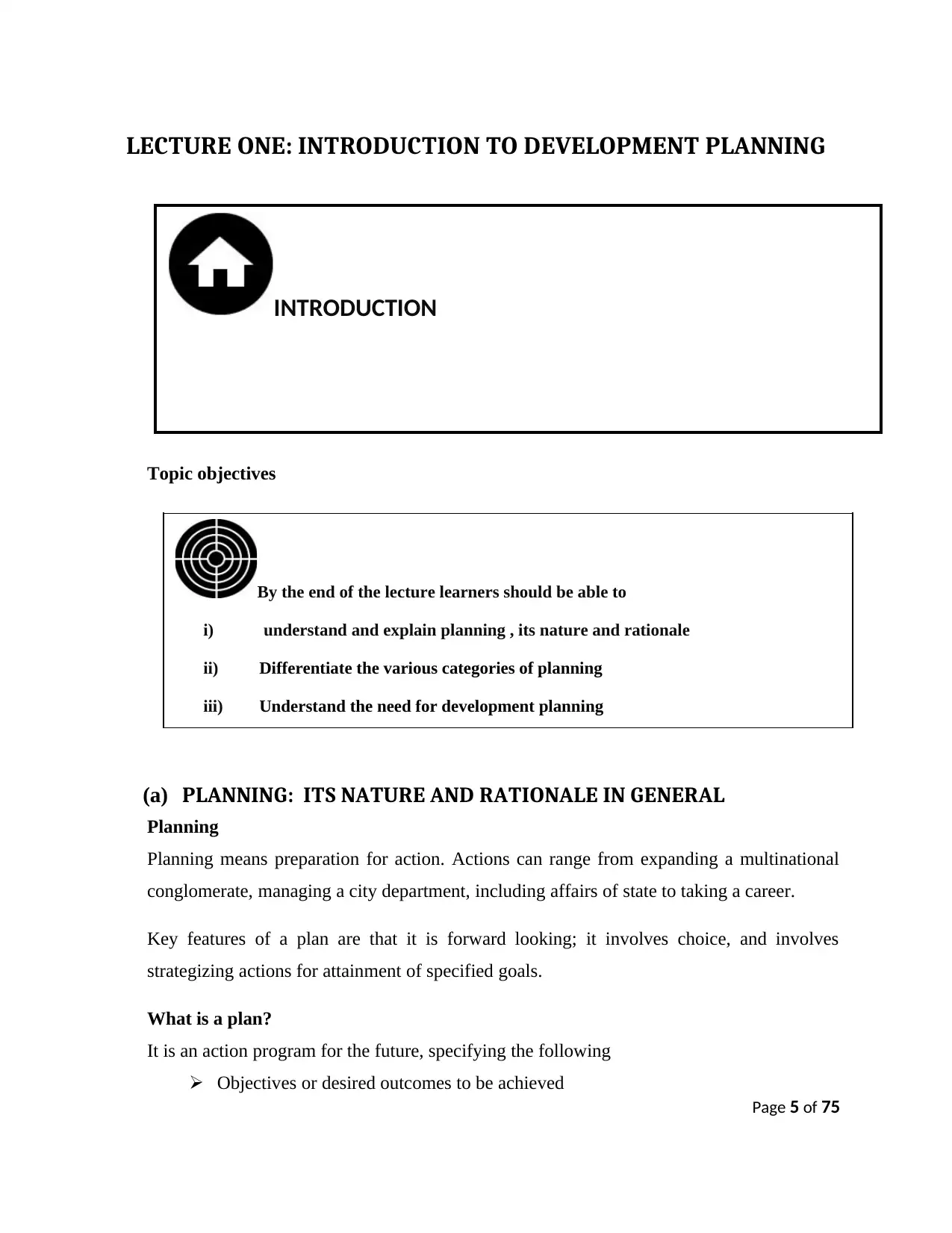
LECTURE ONE: INTRODUCTION TO DEVELOPMENT PLANNING
INTRODUCTION TO DEVELOPMENT PLANNING
Topic objectives
(a) PLANNING: ITS NATURE AND RATIONALE IN GENERAL
Planning
Planning means preparation for action. Actions can range from expanding a multinational
conglomerate, managing a city department, including affairs of state to taking a career.
Key features of a plan are that it is forward looking; it involves choice, and involves
strategizing actions for attainment of specified goals.
What is a plan?
It is an action program for the future, specifying the following
Objectives or desired outcomes to be achieved
Page 5 of 75
INTRODUCTION
By the end of the lecture learners should be able to
i) understand and explain planning , its nature and rationale
ii) Differentiate the various categories of planning
iii) Understand the need for development planning
INTRODUCTION TO DEVELOPMENT PLANNING
Topic objectives
(a) PLANNING: ITS NATURE AND RATIONALE IN GENERAL
Planning
Planning means preparation for action. Actions can range from expanding a multinational
conglomerate, managing a city department, including affairs of state to taking a career.
Key features of a plan are that it is forward looking; it involves choice, and involves
strategizing actions for attainment of specified goals.
What is a plan?
It is an action program for the future, specifying the following
Objectives or desired outcomes to be achieved
Page 5 of 75
INTRODUCTION
By the end of the lecture learners should be able to
i) understand and explain planning , its nature and rationale
ii) Differentiate the various categories of planning
iii) Understand the need for development planning
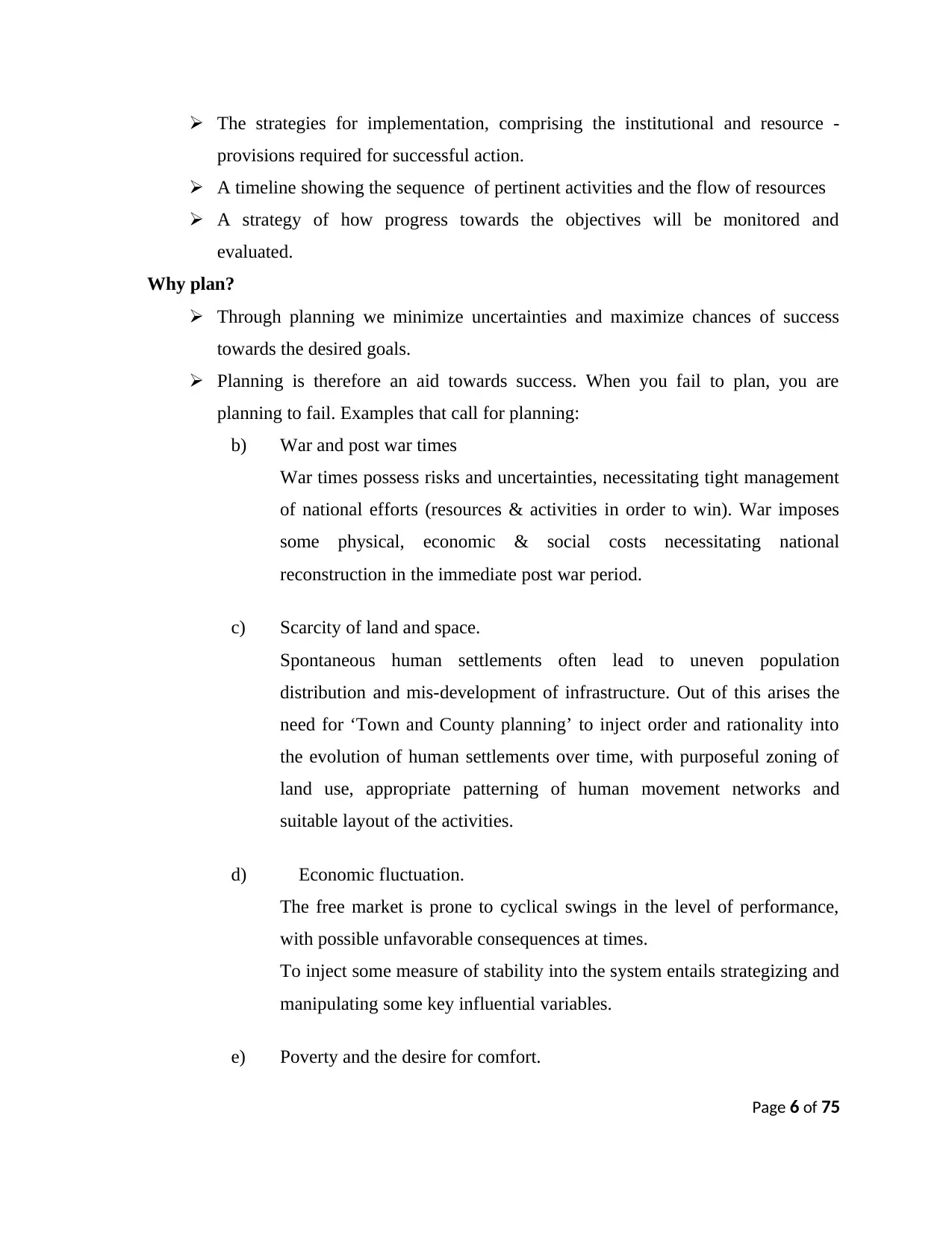
The strategies for implementation, comprising the institutional and resource -
provisions required for successful action.
A timeline showing the sequence of pertinent activities and the flow of resources
A strategy of how progress towards the objectives will be monitored and
evaluated.
Why plan?
Through planning we minimize uncertainties and maximize chances of success
towards the desired goals.
Planning is therefore an aid towards success. When you fail to plan, you are
planning to fail. Examples that call for planning:
b) War and post war times
War times possess risks and uncertainties, necessitating tight management
of national efforts (resources & activities in order to win). War imposes
some physical, economic & social costs necessitating national
reconstruction in the immediate post war period.
c) Scarcity of land and space.
Spontaneous human settlements often lead to uneven population
distribution and mis-development of infrastructure. Out of this arises the
need for ‘Town and County planning’ to inject order and rationality into
the evolution of human settlements over time, with purposeful zoning of
land use, appropriate patterning of human movement networks and
suitable layout of the activities.
d) Economic fluctuation.
The free market is prone to cyclical swings in the level of performance,
with possible unfavorable consequences at times.
To inject some measure of stability into the system entails strategizing and
manipulating some key influential variables.
e) Poverty and the desire for comfort.
Page 6 of 75
provisions required for successful action.
A timeline showing the sequence of pertinent activities and the flow of resources
A strategy of how progress towards the objectives will be monitored and
evaluated.
Why plan?
Through planning we minimize uncertainties and maximize chances of success
towards the desired goals.
Planning is therefore an aid towards success. When you fail to plan, you are
planning to fail. Examples that call for planning:
b) War and post war times
War times possess risks and uncertainties, necessitating tight management
of national efforts (resources & activities in order to win). War imposes
some physical, economic & social costs necessitating national
reconstruction in the immediate post war period.
c) Scarcity of land and space.
Spontaneous human settlements often lead to uneven population
distribution and mis-development of infrastructure. Out of this arises the
need for ‘Town and County planning’ to inject order and rationality into
the evolution of human settlements over time, with purposeful zoning of
land use, appropriate patterning of human movement networks and
suitable layout of the activities.
d) Economic fluctuation.
The free market is prone to cyclical swings in the level of performance,
with possible unfavorable consequences at times.
To inject some measure of stability into the system entails strategizing and
manipulating some key influential variables.
e) Poverty and the desire for comfort.
Page 6 of 75
⊘ This is a preview!⊘
Do you want full access?
Subscribe today to unlock all pages.

Trusted by 1+ million students worldwide
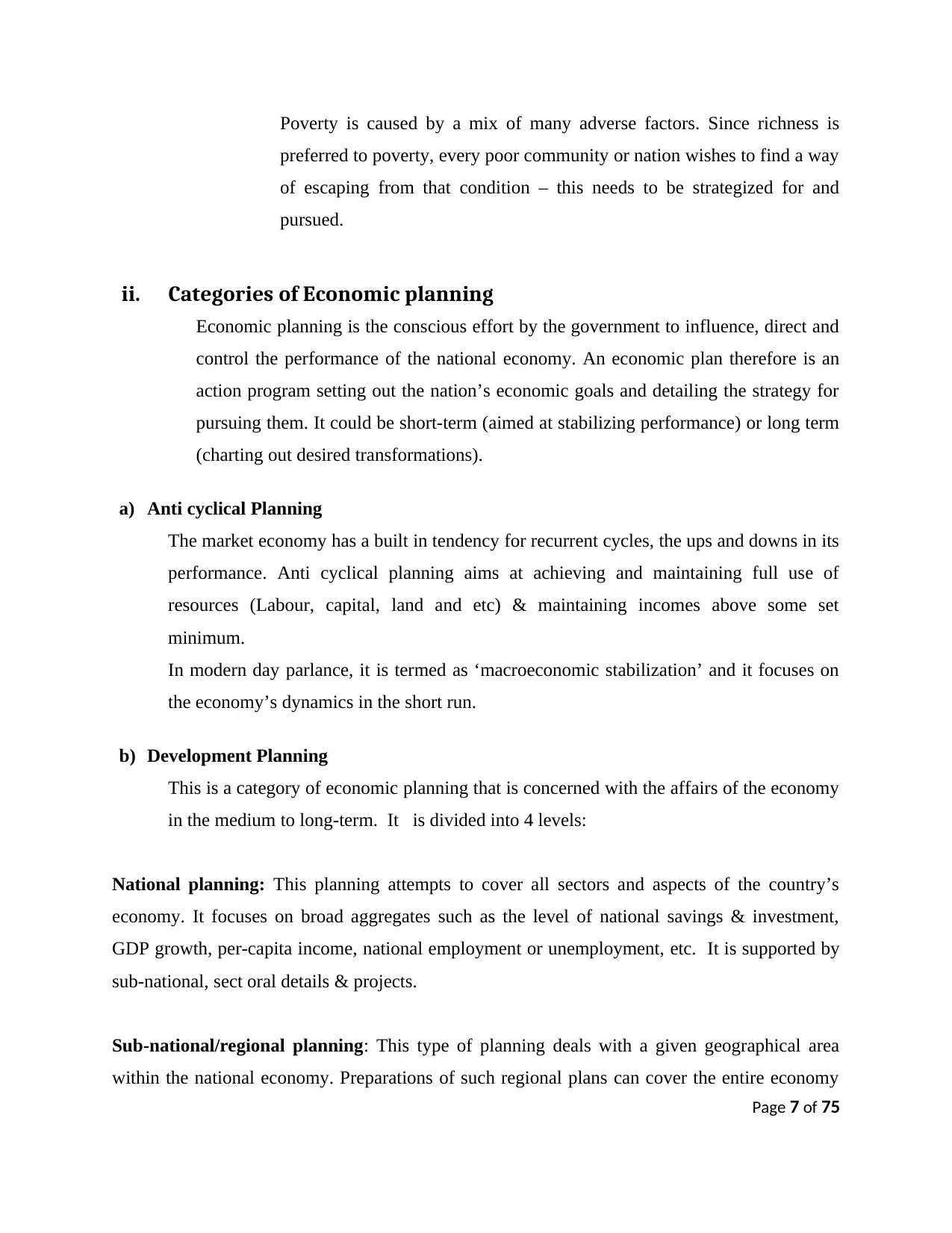
Poverty is caused by a mix of many adverse factors. Since richness is
preferred to poverty, every poor community or nation wishes to find a way
of escaping from that condition – this needs to be strategized for and
pursued.
ii. Categories of Economic planning
Economic planning is the conscious effort by the government to influence, direct and
control the performance of the national economy. An economic plan therefore is an
action program setting out the nation’s economic goals and detailing the strategy for
pursuing them. It could be short-term (aimed at stabilizing performance) or long term
(charting out desired transformations).
a) Anti cyclical Planning
The market economy has a built in tendency for recurrent cycles, the ups and downs in its
performance. Anti cyclical planning aims at achieving and maintaining full use of
resources (Labour, capital, land and etc) & maintaining incomes above some set
minimum.
In modern day parlance, it is termed as ‘macroeconomic stabilization’ and it focuses on
the economy’s dynamics in the short run.
b) Development Planning
This is a category of economic planning that is concerned with the affairs of the economy
in the medium to long-term. It is divided into 4 levels:
National planning: This planning attempts to cover all sectors and aspects of the country’s
economy. It focuses on broad aggregates such as the level of national savings & investment,
GDP growth, per-capita income, national employment or unemployment, etc. It is supported by
sub-national, sect oral details & projects.
Sub-national/regional planning: This type of planning deals with a given geographical area
within the national economy. Preparations of such regional plans can cover the entire economy
Page 7 of 75
preferred to poverty, every poor community or nation wishes to find a way
of escaping from that condition – this needs to be strategized for and
pursued.
ii. Categories of Economic planning
Economic planning is the conscious effort by the government to influence, direct and
control the performance of the national economy. An economic plan therefore is an
action program setting out the nation’s economic goals and detailing the strategy for
pursuing them. It could be short-term (aimed at stabilizing performance) or long term
(charting out desired transformations).
a) Anti cyclical Planning
The market economy has a built in tendency for recurrent cycles, the ups and downs in its
performance. Anti cyclical planning aims at achieving and maintaining full use of
resources (Labour, capital, land and etc) & maintaining incomes above some set
minimum.
In modern day parlance, it is termed as ‘macroeconomic stabilization’ and it focuses on
the economy’s dynamics in the short run.
b) Development Planning
This is a category of economic planning that is concerned with the affairs of the economy
in the medium to long-term. It is divided into 4 levels:
National planning: This planning attempts to cover all sectors and aspects of the country’s
economy. It focuses on broad aggregates such as the level of national savings & investment,
GDP growth, per-capita income, national employment or unemployment, etc. It is supported by
sub-national, sect oral details & projects.
Sub-national/regional planning: This type of planning deals with a given geographical area
within the national economy. Preparations of such regional plans can cover the entire economy
Page 7 of 75
Paraphrase This Document
Need a fresh take? Get an instant paraphrase of this document with our AI Paraphraser
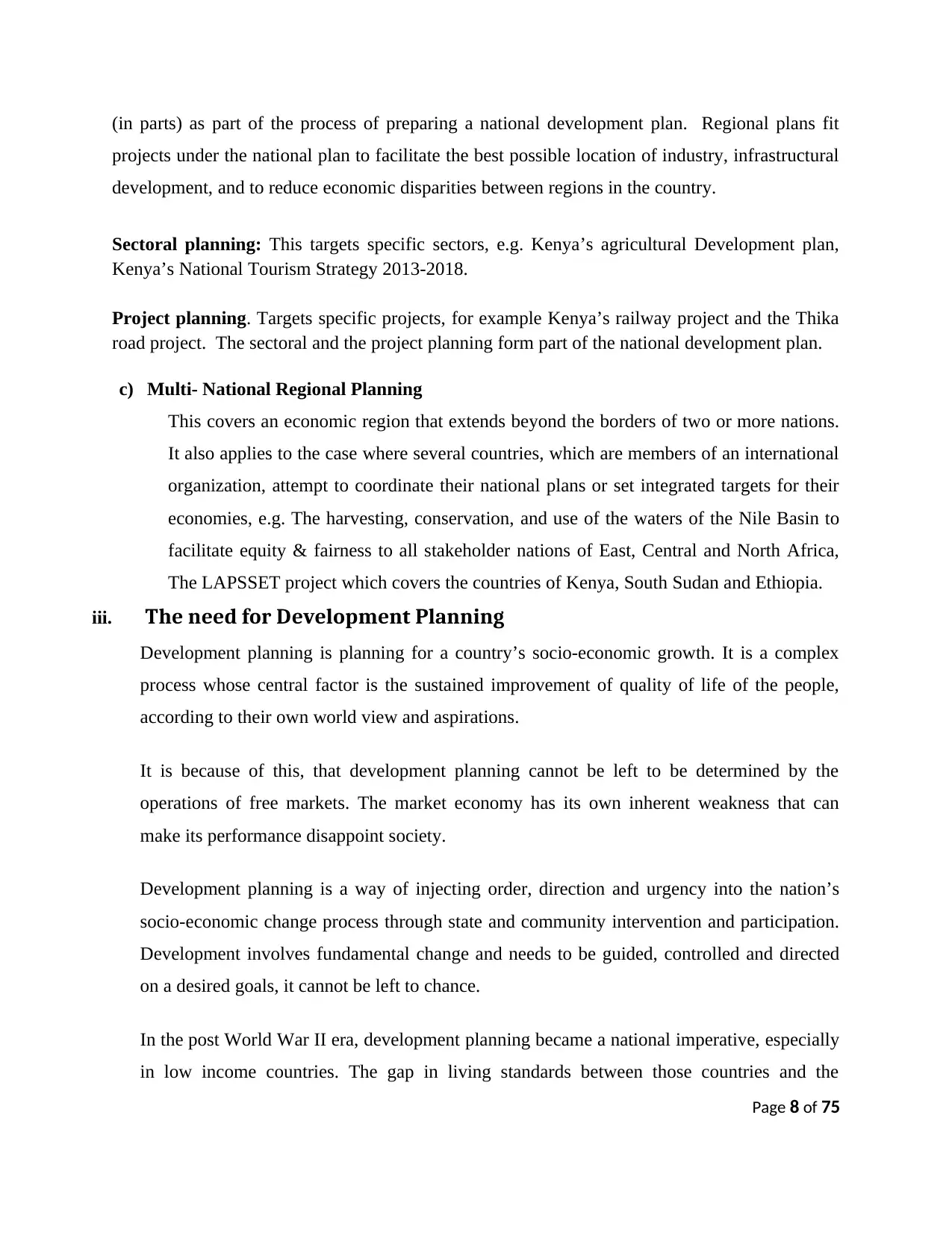
(in parts) as part of the process of preparing a national development plan. Regional plans fit
projects under the national plan to facilitate the best possible location of industry, infrastructural
development, and to reduce economic disparities between regions in the country.
Sectoral planning: This targets specific sectors, e.g. Kenya’s agricultural Development plan,
Kenya’s National Tourism Strategy 2013-2018.
Project planning. Targets specific projects, for example Kenya’s railway project and the Thika
road project. The sectoral and the project planning form part of the national development plan.
c) Multi- National Regional Planning
This covers an economic region that extends beyond the borders of two or more nations.
It also applies to the case where several countries, which are members of an international
organization, attempt to coordinate their national plans or set integrated targets for their
economies, e.g. The harvesting, conservation, and use of the waters of the Nile Basin to
facilitate equity & fairness to all stakeholder nations of East, Central and North Africa,
The LAPSSET project which covers the countries of Kenya, South Sudan and Ethiopia.
iii. The need for Development Planning
Development planning is planning for a country’s socio-economic growth. It is a complex
process whose central factor is the sustained improvement of quality of life of the people,
according to their own world view and aspirations.
It is because of this, that development planning cannot be left to be determined by the
operations of free markets. The market economy has its own inherent weakness that can
make its performance disappoint society.
Development planning is a way of injecting order, direction and urgency into the nation’s
socio-economic change process through state and community intervention and participation.
Development involves fundamental change and needs to be guided, controlled and directed
on a desired goals, it cannot be left to chance.
In the post World War II era, development planning became a national imperative, especially
in low income countries. The gap in living standards between those countries and the
Page 8 of 75
projects under the national plan to facilitate the best possible location of industry, infrastructural
development, and to reduce economic disparities between regions in the country.
Sectoral planning: This targets specific sectors, e.g. Kenya’s agricultural Development plan,
Kenya’s National Tourism Strategy 2013-2018.
Project planning. Targets specific projects, for example Kenya’s railway project and the Thika
road project. The sectoral and the project planning form part of the national development plan.
c) Multi- National Regional Planning
This covers an economic region that extends beyond the borders of two or more nations.
It also applies to the case where several countries, which are members of an international
organization, attempt to coordinate their national plans or set integrated targets for their
economies, e.g. The harvesting, conservation, and use of the waters of the Nile Basin to
facilitate equity & fairness to all stakeholder nations of East, Central and North Africa,
The LAPSSET project which covers the countries of Kenya, South Sudan and Ethiopia.
iii. The need for Development Planning
Development planning is planning for a country’s socio-economic growth. It is a complex
process whose central factor is the sustained improvement of quality of life of the people,
according to their own world view and aspirations.
It is because of this, that development planning cannot be left to be determined by the
operations of free markets. The market economy has its own inherent weakness that can
make its performance disappoint society.
Development planning is a way of injecting order, direction and urgency into the nation’s
socio-economic change process through state and community intervention and participation.
Development involves fundamental change and needs to be guided, controlled and directed
on a desired goals, it cannot be left to chance.
In the post World War II era, development planning became a national imperative, especially
in low income countries. The gap in living standards between those countries and the
Page 8 of 75
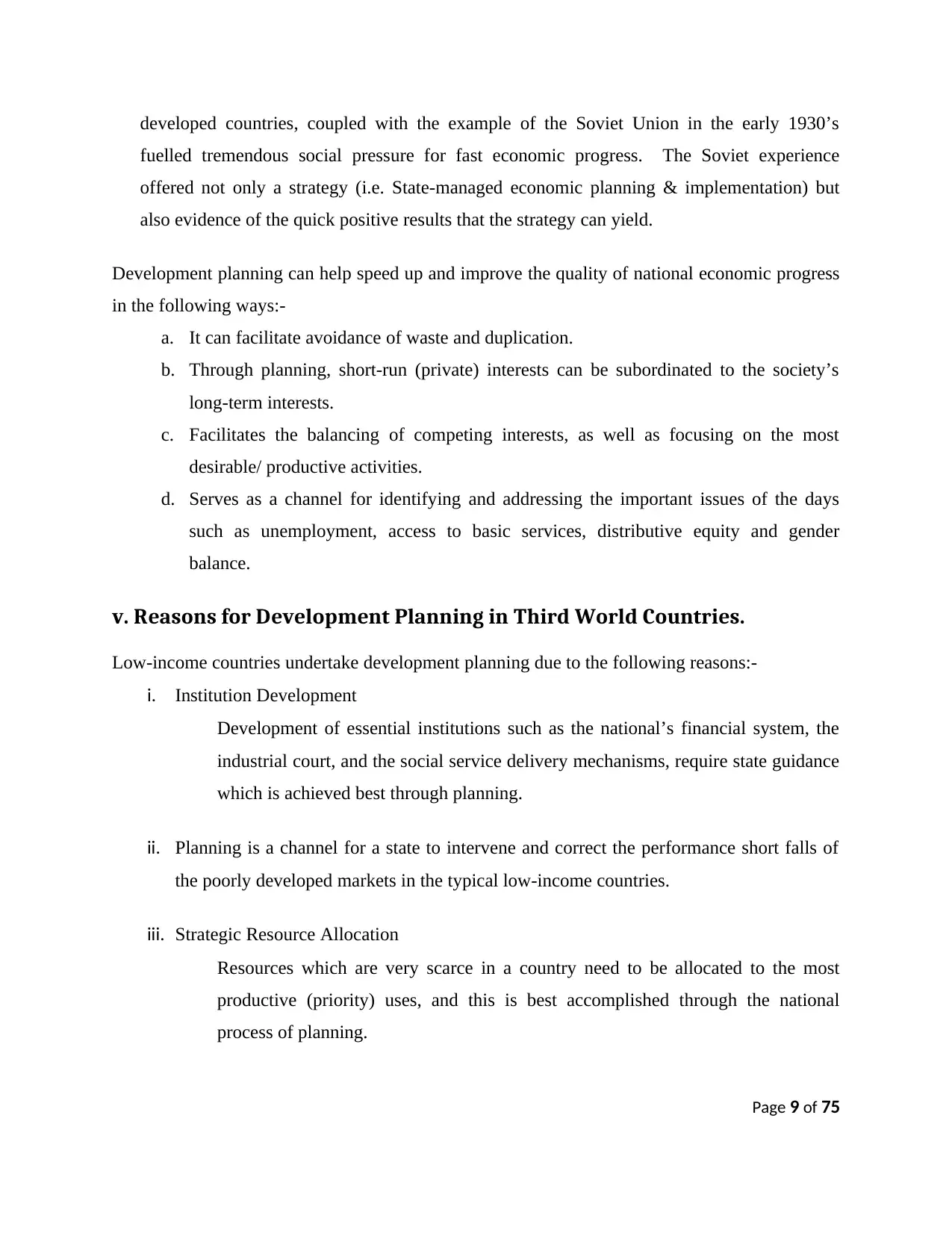
developed countries, coupled with the example of the Soviet Union in the early 1930’s
fuelled tremendous social pressure for fast economic progress. The Soviet experience
offered not only a strategy (i.e. State-managed economic planning & implementation) but
also evidence of the quick positive results that the strategy can yield.
Development planning can help speed up and improve the quality of national economic progress
in the following ways:-
a. It can facilitate avoidance of waste and duplication.
b. Through planning, short-run (private) interests can be subordinated to the society’s
long-term interests.
c. Facilitates the balancing of competing interests, as well as focusing on the most
desirable/ productive activities.
d. Serves as a channel for identifying and addressing the important issues of the days
such as unemployment, access to basic services, distributive equity and gender
balance.
v. Reasons for Development Planning in Third World Countries.
Low-income countries undertake development planning due to the following reasons:-
i. Institution Development
Development of essential institutions such as the national’s financial system, the
industrial court, and the social service delivery mechanisms, require state guidance
which is achieved best through planning.
ii. Planning is a channel for a state to intervene and correct the performance short falls of
the poorly developed markets in the typical low-income countries.
iii. Strategic Resource Allocation
Resources which are very scarce in a country need to be allocated to the most
productive (priority) uses, and this is best accomplished through the national
process of planning.
Page 9 of 75
fuelled tremendous social pressure for fast economic progress. The Soviet experience
offered not only a strategy (i.e. State-managed economic planning & implementation) but
also evidence of the quick positive results that the strategy can yield.
Development planning can help speed up and improve the quality of national economic progress
in the following ways:-
a. It can facilitate avoidance of waste and duplication.
b. Through planning, short-run (private) interests can be subordinated to the society’s
long-term interests.
c. Facilitates the balancing of competing interests, as well as focusing on the most
desirable/ productive activities.
d. Serves as a channel for identifying and addressing the important issues of the days
such as unemployment, access to basic services, distributive equity and gender
balance.
v. Reasons for Development Planning in Third World Countries.
Low-income countries undertake development planning due to the following reasons:-
i. Institution Development
Development of essential institutions such as the national’s financial system, the
industrial court, and the social service delivery mechanisms, require state guidance
which is achieved best through planning.
ii. Planning is a channel for a state to intervene and correct the performance short falls of
the poorly developed markets in the typical low-income countries.
iii. Strategic Resource Allocation
Resources which are very scarce in a country need to be allocated to the most
productive (priority) uses, and this is best accomplished through the national
process of planning.
Page 9 of 75
⊘ This is a preview!⊘
Do you want full access?
Subscribe today to unlock all pages.

Trusted by 1+ million students worldwide
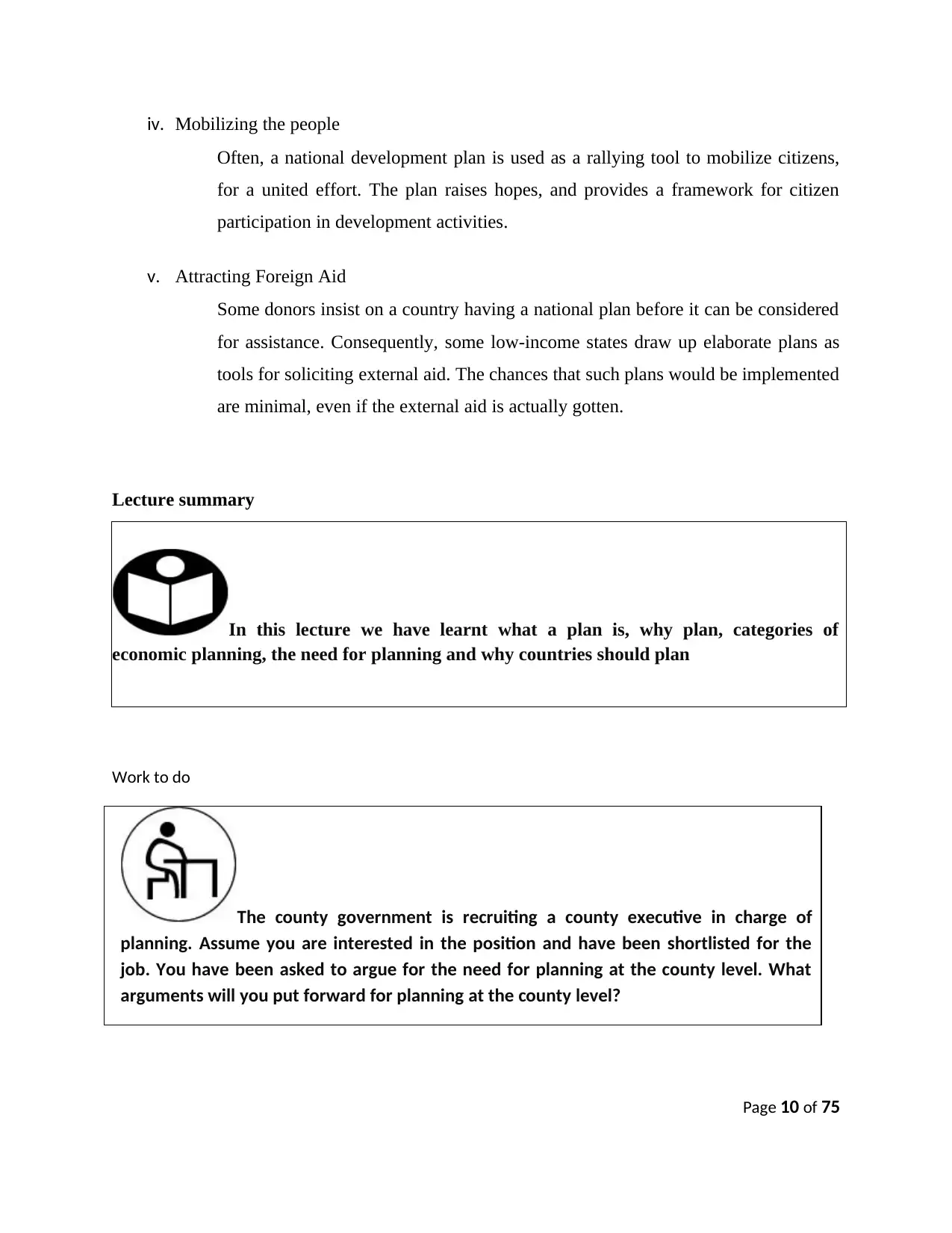
iv. Mobilizing the people
Often, a national development plan is used as a rallying tool to mobilize citizens,
for a united effort. The plan raises hopes, and provides a framework for citizen
participation in development activities.
v. Attracting Foreign Aid
Some donors insist on a country having a national plan before it can be considered
for assistance. Consequently, some low-income states draw up elaborate plans as
tools for soliciting external aid. The chances that such plans would be implemented
are minimal, even if the external aid is actually gotten.
Lecture summary
In this lecture we have learnt what a plan is, why plan, categories of
economic planning, the need for planning and why countries should plan
Work to do
The county government is recruiting a county executive in charge of
planning. Assume you are interested in the position and have been shortlisted for the
job. You have been asked to argue for the need for planning at the county level. What
arguments will you put forward for planning at the county level?
Page 10 of 75
Often, a national development plan is used as a rallying tool to mobilize citizens,
for a united effort. The plan raises hopes, and provides a framework for citizen
participation in development activities.
v. Attracting Foreign Aid
Some donors insist on a country having a national plan before it can be considered
for assistance. Consequently, some low-income states draw up elaborate plans as
tools for soliciting external aid. The chances that such plans would be implemented
are minimal, even if the external aid is actually gotten.
Lecture summary
In this lecture we have learnt what a plan is, why plan, categories of
economic planning, the need for planning and why countries should plan
Work to do
The county government is recruiting a county executive in charge of
planning. Assume you are interested in the position and have been shortlisted for the
job. You have been asked to argue for the need for planning at the county level. What
arguments will you put forward for planning at the county level?
Page 10 of 75
Paraphrase This Document
Need a fresh take? Get an instant paraphrase of this document with our AI Paraphraser
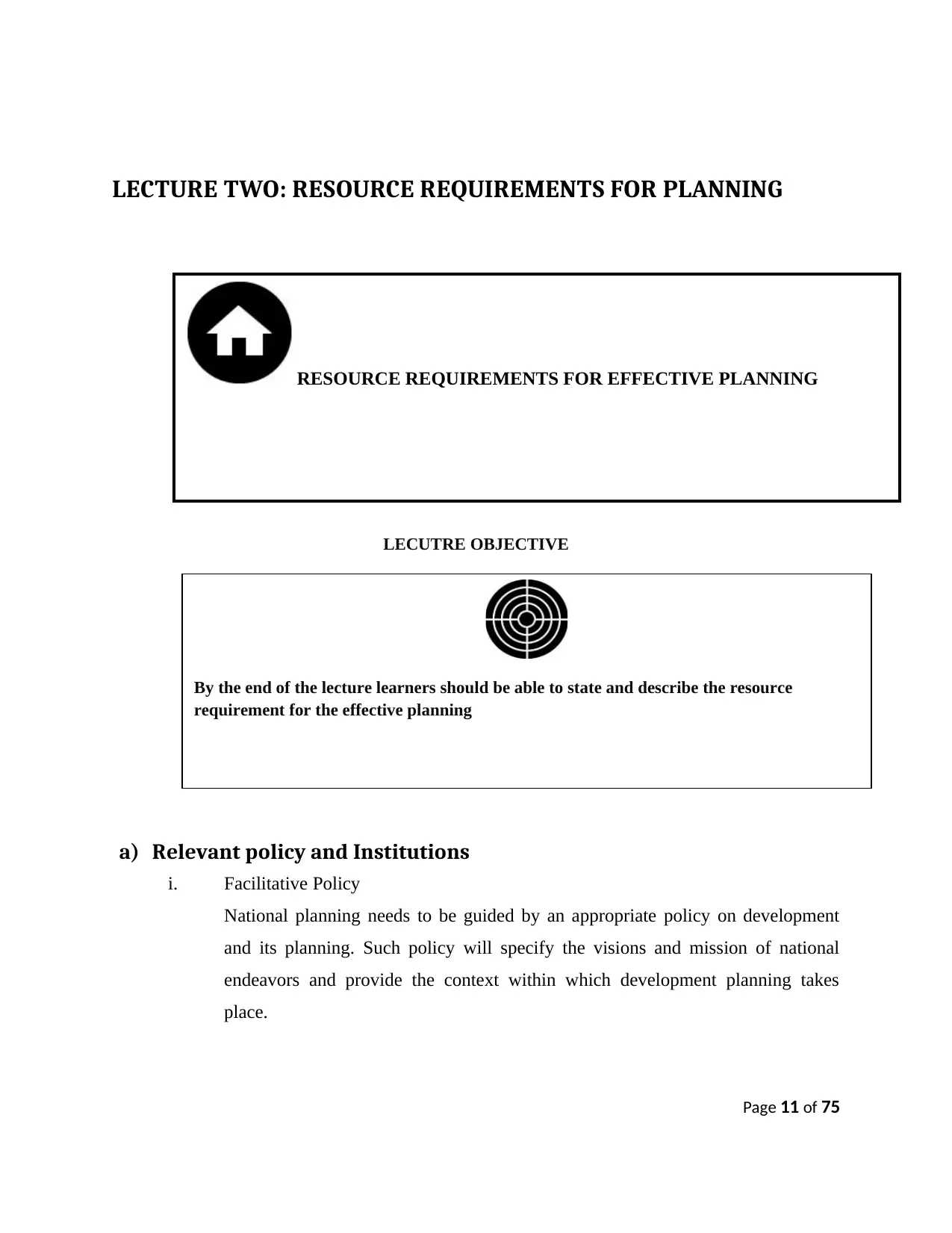
LECTURE TWO: RESOURCE REQUIREMENTS FOR PLANNING
LECUTRE OBJECTIVE
a) Relevant policy and Institutions
i. Facilitative Policy
National planning needs to be guided by an appropriate policy on development
and its planning. Such policy will specify the visions and mission of national
endeavors and provide the context within which development planning takes
place.
Page 11 of 75
RESOURCE REQUIREMENTS FOR EFFECTIVE PLANNING
By the end of the lecture learners should be able to state and describe the resource
requirement for the effective planning
LECUTRE OBJECTIVE
a) Relevant policy and Institutions
i. Facilitative Policy
National planning needs to be guided by an appropriate policy on development
and its planning. Such policy will specify the visions and mission of national
endeavors and provide the context within which development planning takes
place.
Page 11 of 75
RESOURCE REQUIREMENTS FOR EFFECTIVE PLANNING
By the end of the lecture learners should be able to state and describe the resource
requirement for the effective planning
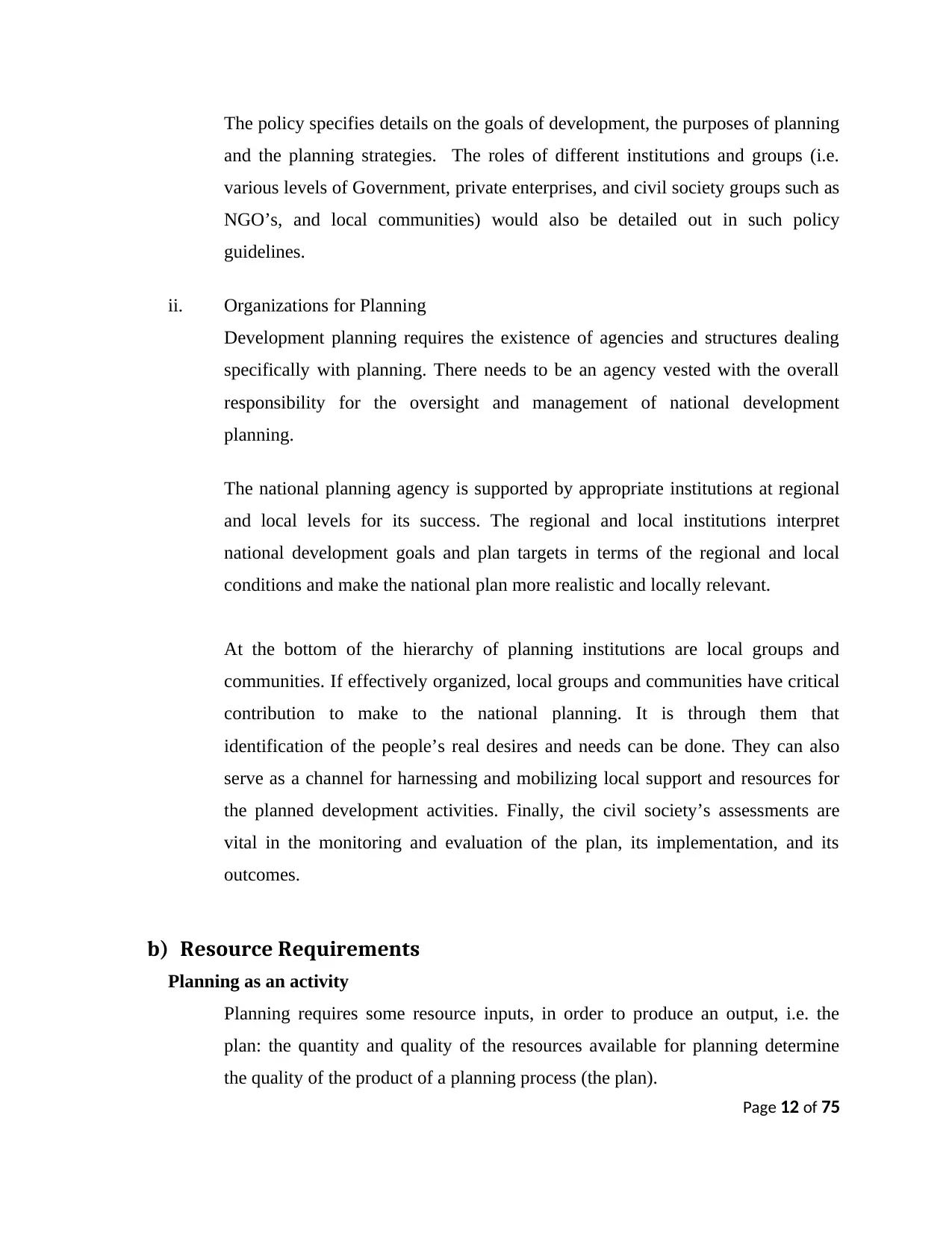
The policy specifies details on the goals of development, the purposes of planning
and the planning strategies. The roles of different institutions and groups (i.e.
various levels of Government, private enterprises, and civil society groups such as
NGO’s, and local communities) would also be detailed out in such policy
guidelines.
ii. Organizations for Planning
Development planning requires the existence of agencies and structures dealing
specifically with planning. There needs to be an agency vested with the overall
responsibility for the oversight and management of national development
planning.
The national planning agency is supported by appropriate institutions at regional
and local levels for its success. The regional and local institutions interpret
national development goals and plan targets in terms of the regional and local
conditions and make the national plan more realistic and locally relevant.
At the bottom of the hierarchy of planning institutions are local groups and
communities. If effectively organized, local groups and communities have critical
contribution to make to the national planning. It is through them that
identification of the people’s real desires and needs can be done. They can also
serve as a channel for harnessing and mobilizing local support and resources for
the planned development activities. Finally, the civil society’s assessments are
vital in the monitoring and evaluation of the plan, its implementation, and its
outcomes.
b) Resource Requirements
Planning as an activity
Planning requires some resource inputs, in order to produce an output, i.e. the
plan: the quantity and quality of the resources available for planning determine
the quality of the product of a planning process (the plan).
Page 12 of 75
and the planning strategies. The roles of different institutions and groups (i.e.
various levels of Government, private enterprises, and civil society groups such as
NGO’s, and local communities) would also be detailed out in such policy
guidelines.
ii. Organizations for Planning
Development planning requires the existence of agencies and structures dealing
specifically with planning. There needs to be an agency vested with the overall
responsibility for the oversight and management of national development
planning.
The national planning agency is supported by appropriate institutions at regional
and local levels for its success. The regional and local institutions interpret
national development goals and plan targets in terms of the regional and local
conditions and make the national plan more realistic and locally relevant.
At the bottom of the hierarchy of planning institutions are local groups and
communities. If effectively organized, local groups and communities have critical
contribution to make to the national planning. It is through them that
identification of the people’s real desires and needs can be done. They can also
serve as a channel for harnessing and mobilizing local support and resources for
the planned development activities. Finally, the civil society’s assessments are
vital in the monitoring and evaluation of the plan, its implementation, and its
outcomes.
b) Resource Requirements
Planning as an activity
Planning requires some resource inputs, in order to produce an output, i.e. the
plan: the quantity and quality of the resources available for planning determine
the quality of the product of a planning process (the plan).
Page 12 of 75
⊘ This is a preview!⊘
Do you want full access?
Subscribe today to unlock all pages.

Trusted by 1+ million students worldwide
1 out of 75
Related Documents
Your All-in-One AI-Powered Toolkit for Academic Success.
+13062052269
info@desklib.com
Available 24*7 on WhatsApp / Email
![[object Object]](/_next/static/media/star-bottom.7253800d.svg)
Unlock your academic potential
Copyright © 2020–2025 A2Z Services. All Rights Reserved. Developed and managed by ZUCOL.





